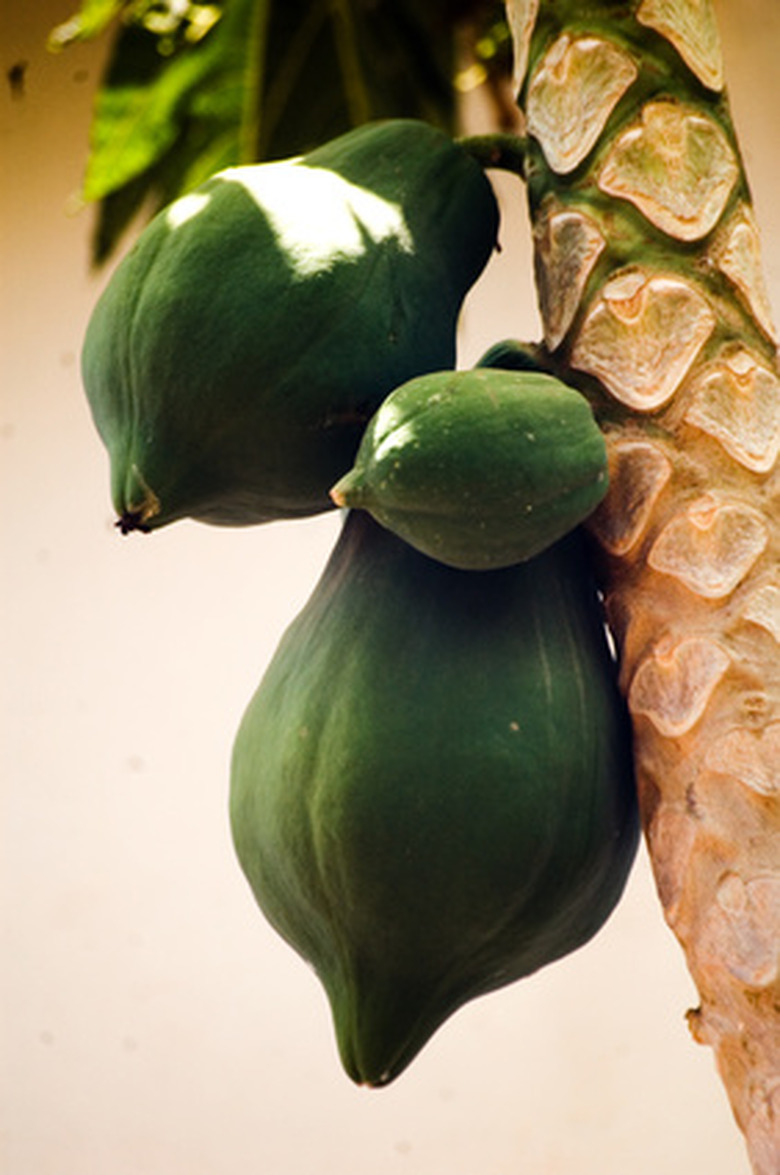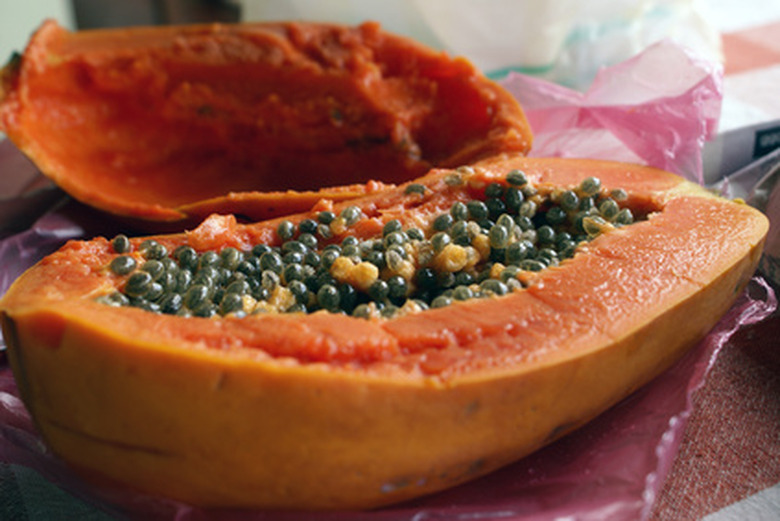Papaya Tree Fertilizer
The papaya, a member of the Caricaceae family, is a tropical fruit grown primarily in Hawaii, in the southwestern United States, and in Mexico and Central America. In both the Mexican and Hawaiian varieties, the fruit, leaves and seeds are edible. If you plan to grow a papaya in a container or from seed, you should understand its nutrient requirements. The papaya is a heavy feeder, and choosing the best fertilizer is essential to growing a lush tree.
Background on Papaya
Papayas grow best in regions where annual temperatures stay between 70 and 80 degrees Fahrenheit and annual rainfall averages 40 inches. Although the papaya can grow upward of 30 feet at maturity, it is really a short-lived perennial herbaceous plant that lives at most four years. All parts, including the fruit, flowers and leaves, are edible and the papaya blooms continuously under the right conditions.
- The papaya, a member of the Caricaceae family, is a tropical fruit grown primarily in Hawaii, in the southwestern United States, and in Mexico and Central America.
- All parts, including the fruit, flowers and leaves, are edible and the papaya blooms continuously under the right conditions.
A tree can be male, female or hermaphroditic, but it's difficult to ascertain sex until the plant blooms. Male blooms have clusters of small white blossoms on branched tentacles that can be nearly 18 inches in length. Female blossoms are slightly larger with a single white blossom, with straight petals surrounding a miniature fruit close to the stem. The hermaphrodite has both male and female components in one blossom so it can self-pollinate.
Optimal Soil Conditions
Papayas do well in light, porous, nutrient-rich soil that drains well. Plants should be watered regularly, but not to the point where water pools. Too much water can lead to root rot. In winter, the papaya prefers drier conditions. A slightly acidic soil mix is best, with a pH range of 5.5. to 6.7.
- A tree can be male, female or hermaphroditic, but it's difficult to ascertain sex until the plant blooms.
Fertilizer
According to the University of Florida Institute of Food and Agricultural Sciences (IFAS), small amounts of fertilizer should be applied and adjusted as the papaya tree grows. A complete fertilizer should be layered around the drip line, and amounts should be increased as the tree grows. A complete fertilizer includes essential plant nutrients, including nitrogen, phosphate, potash and magnesium. If you're using an organic fertilizer, spread a layer of compost and supplement with nitrogen-rich sources of organic matter like blood meal, fish emulsion, bat guano or manure. The best course of action in feeding is to observe how the papaya reacts. If leaves take on a purplish or reddish cast, then the tree is potentially low on phosphorous.
Fertilizer Frequency
Young papaya plants should be fertilized with a slow-release, nitrogen-rich fertilizer every 14 days and a 1/4-lb. of complete fertilizer. As trees grow larger, the fertilizer portion should be increased to 1 to 2 lbs. every other month. Because compost provides a continuous slow-release form of nitrogen, which might not be enough to support the papaya's rapid growth, add nitrogen fertilizer monthly. Adjust the amount based on the tree's response.
- According to the University of Florida Institute of Food and Agricultural Sciences (IFAS), small amounts of fertilizer should be applied and adjusted as the papaya tree grows.
- A complete fertilizer should be layered around the drip line, and amounts should be increased as the tree grows.
Test soil pH periodically. If soil becomes too acidic (less than 5), then add iron sulfate and potentially small portions of agricultural lime. If soil becomes too base (more than 7), add chelated iron mixed in water and apply as a soil drench.
Growing in Pots
Because of climate, poor soil conditions or space constraints, some gardeners choose to grow papaya trees in containers. When summer conditions are hot and sunny, the plant can be moved outside. In winter, it can be moved near a window with southern exposure.
If you've transplanted a papaya tree from another container or from the outside, wait until you see new growth before you fertilize. Take caution with container papaya trees. Too much fertilizer inhibits growth. A complete or balanced fertilizer with equal proportions of nitrogen, phosphorous and magnesium may be used. In addition, water-soluble fertilizers can be used in accordance with manufacturer's instructions. If the plant looks green and healthy, then it has the correct nutrients.
- Test soil pH periodically.
- If soil becomes too base (more than 7), add chelated iron mixed in water and apply as a soil drench.

